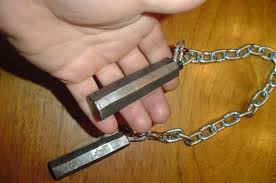Kusari means chain.鎖
Fundo or Fundou means weight.分銅

Kusari-fundo is a weighted short chain weapon. Variations are also called Manriki gusari, Manriki, Surujin, and Suruchin. It is a close range weapon, approximately 18–30 inches (46–76 cm) in length. It is generally constructed of a non-reflective etched steel chain or thick rope for training purposes. This flexible weapon can be used to strike, snare, or entangle an assailant or their weapon.
An interesting note about the Manriki was that it was especially popular with the palace guard of Japan, because it was sacrilege to spill blood on palace grounds, but the chain could strike, strangle and entrap without wounding. I read that it was invented by Masaki Toshimitsu Dannoshin who was the head sentry at Edo castle in the early 1700s. Later the weapon was adopted by constables to capture criminals.
From Wikipedia
Masaki Toshimitsu Dannoshin (正木 俊光?, February 11, 1690 - May 22, 1776) was a famous swordsman of Japan during the 17th century. Dannoshin served as a guard of the Edo Castle. Dannoshin considered killing people on the ground of the palace to be rather sacrilegious. Due to this belief, Dannoshin tried to find a more peaceful way to apprehend intruders. After some time, Dannoshin produced a two-foot-long chain with two weights, one attached to each end, and devised a series of techniques to disarm and subdue an armed opponent. Dannoshin's unique weapon soon became known as the manriki-gusari, in which manriki means "10,000 power", and gusari means "chain".[1] This was because Dannoshin believed that the weapon contained the power and the ingenuity of 10,000 people. This weapon fighting style soon evolved into the Masaki-ryu style.
 |
| Masaki Toshimitsu Dannoshin 正木 俊光 |
Another story I found is about Masaki. Masaki Toshimitsu Dannoshin was a guard at a Buddhist temple gate in Edo in the 1600's. He created the manriki-gusari so he could do his job and not break the Buddhist prohibition against spilling blood. He also developed the techniques for it's use and founded the school that teaches these techniques and bears his name. Was Masaki a palace guard or temple guard?
Some people use it as a throwing or striking weapon
Some schools use it to aid in techniques. Here is a classic looking school performing techniques with the kusari fundo. This film is my favorite of the series.
In modern schools posting on the web, the weapon seems to be predominately used in schools that train in the image of the ninja. The vast majority of people talking about it on the web seem to be from these lineages.
This next film is worth watching for the neat camera setup the guy has.








Nice article! Please feel free to checkout my website at http://www.jinenkanseigi.com/kusarifundo.htm
ReplyDeleteWe sell live kusarifundo, and there is a link there to learn how to make your own soft training kusarifundo as well.
Thanks,
Matt Stennett
Jinenkan Seigi Dojo
Great post! I love some of these alternative weapons. The kusari fundo appears to be a largely psychological weapon. Imagine throwing a punch at someone, and then all of a sudden your wrists are wrapped up with a chain, and you're being thrown in something like an osoto gari, without the benefit of using your hands to break your fall.
ReplyDeleteNothin worse than being thrown AND being scared.
Am I the only person who noticed that almost all of this stuff relies on the aggressor missing? I mean in the last video the woman is wrapping her weapon around an arm that has already finished punching her in the face. The only reason she didn't get punched is that the guy wasn't trying to punch her. In the second video at about 1:00 we have a technique that could easily backfire if you don't have enough slack. I don't see the value in these kinds of demonstrations.
ReplyDeleteThat being said, it is an interesting weapon.
to answer your question... a person is only as good with a weapon as they are without a weapon. And that is a pretty nice weapon for what it is
ReplyDeletei was wondering where i can get a good manrikigusari chain not some cheap one send any info to taoistmonk@comcast.net
ReplyDeletehttps://japaneseart.ecrater.com/c/732391/martial-arts-training-gear
DeleteWONDERFULL THE KURASI FUNDO BETTER THAN GUN
ReplyDeleteAnonymous, you are supposed to step offline of the punch whether you have a weapon or not.
ReplyDeleteThey seemed to have used my photo from my site for kusari fundo . I make and sell them and more feel free to contact me . larsyb@yahoo.com
ReplyDeletehttp://ninpowisconsin.homestead.com/ninjaweapons.html
https://japaneseart.ecrater.com/c/732391/martial-arts-training-gear